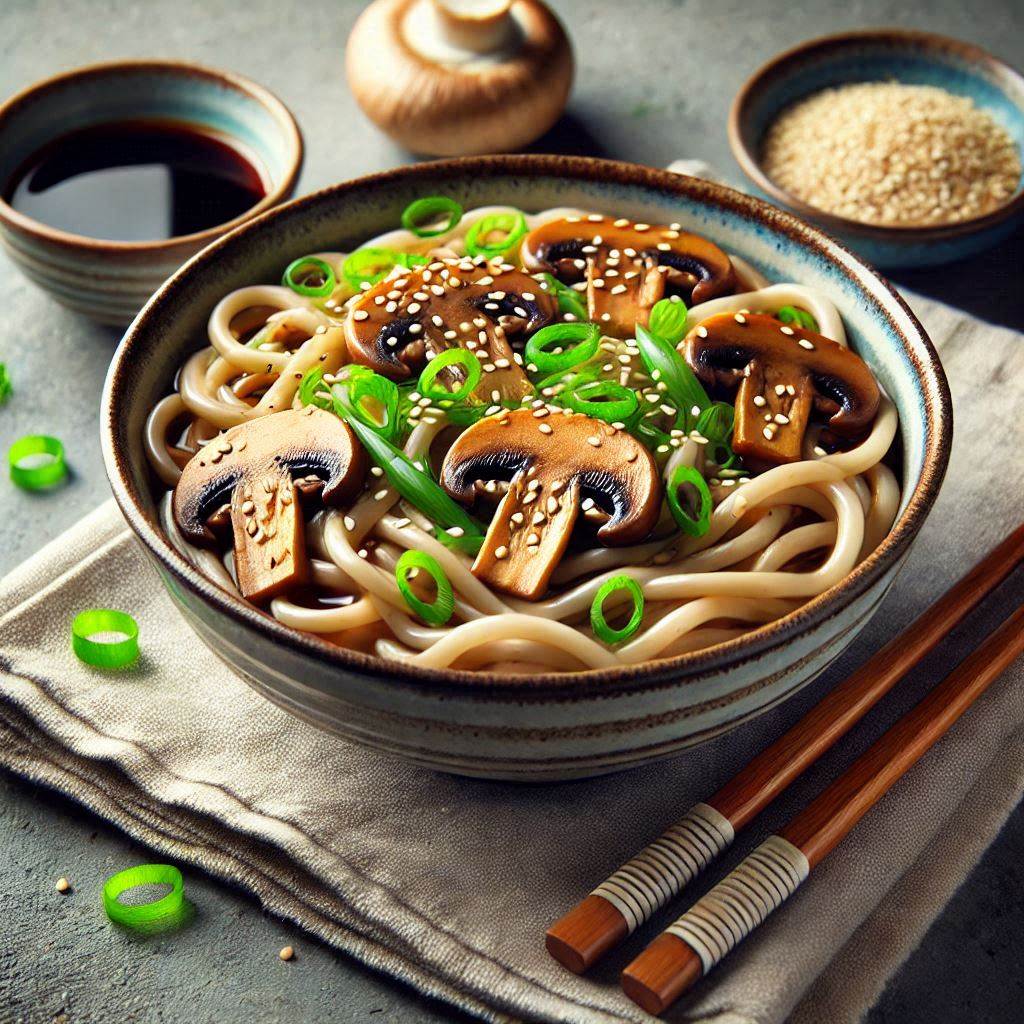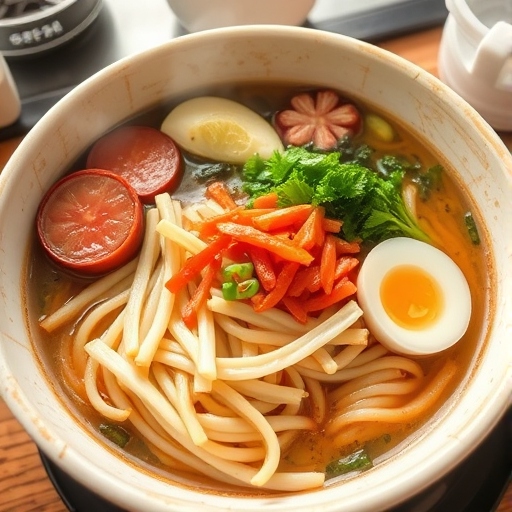Savory Udon served in a hot pot with various ingredients is a delicious and comforting Japanese dish. The thick, chewy udon noodles are cooked in a flavorful broth, typically made from dashi, soy sauce, and mirin. Various ingredients are added to enhance the flavor and texture, such as thinly sliced meat (like beef or chicken), vegetables (like mushrooms, spinach, and onions), tofu, and sometimes seafood. The hot pot is simmered to allow the flavors to meld together, and it’s often served with garnishes like green onions, tempura, or a boiled egg. The dish is perfect for cold weather and family-style dining.
Udon Hot Pot Recipe
Course: Udon Hot PotCuisine: JapaneseDifficulty: Easy4
servings10
minutes10
minutes300
kcalIngredients
Udon Noodles: 400 g
Protein:Ground Pork: 250 g (or chicken, shrimp, or tofu)Vegetables:Onion: 1 small, chopped
Mushrooms: Handful (shiitake or any preferred type)
Snow Peas: Handful, cut into bite-size pieces
Green Onions: Handful, chopped diagonally
Kabocha Squash: ¼, cut into bite-size pieces (optional)Broth:Water: 800 ml
Dashi Powder: To taste (or homemade dashi)
Fish Sauce: 2 tbsp
Oyster Sauce: 2 tbsp
Mirin: 1 tbsp (optional)Toppings:Kamaboko (fish cake): Slices (optional)
Tempura Shrimp: 2 pieces (optional)
Boiled Egg: 1 per serving (optional)
You Tiao (Chinese bread stick): Sliced for garnish
Directions
- Prepare the Broth:In a large pot, heat a tablespoon of oil over medium heat.
Add the ground pork and chopped onion. Stir-fry until the meat is browned.
Stir in fish sauce, oyster sauce, and dashi powder. Mix well. - Add Water and Vegetables:Pour in the water and bring to a boil.
Add mushrooms, kabocha squash, and snow peas. Simmer until the vegetables are tender. - Cook Udon Noodles:Add the udon noodles to the pot and cook according to package instructions, usually about 3-5 minutes.
- Final Touches:If using, gently add kamaboko slices and tempura shrimp to the pot.
Crack an egg into the pot if desired and cover to cook until the egg is set to your liking.
Serve:Ladle the hot pot into bowls.
Garnish with chopped green onions and slices of you tiao.
Enjoy your udon hot pot immediately!
Notes
- Customize your hot pot by adding any seasonal vegetables or proteins you prefer.
Adjust the seasoning according to your taste preference; add more dashi or fish sauce for a richer flavor. - This recipe combines various ingredients for a hearty and flavorful udon hot pot experience that warms you up on cold days!
- The dish is often served family-style, where everyone can gather around the pot and help themselves to the ingredients. It’s a cozy and interactive meal, making it perfect for sharing with loved ones. The combination of the rich, savory broth, soft udon noodles, and various ingredients creates a satisfying and warming meal.
Savoring Comfort: The Ultimate Guide to Delightful Udon Hot Pot Experiences
https://noodlesbenefits.com/curry-udon-is-a-popular-japanese-noodle-dish/Udon hot pot, a heartwarming dish that combines thick, chewy noodles with a flavorful broth and an array of ingredients, has become increasingly popular among food enthusiasts. This comforting meal not only warms the body but also brings people together, making it perfect for social gatherings or cozy nights in. As we delve into the world of this Japanese-inspired culinary delight, we’ll explore its various components, preparation methods, and the joy it brings to those who partake in this communal dining experience.
In this comprehensive Savory Mushroom Udon: A Comforting Bowl of Umami Delight review, we’ll take you on a journey through the rich flavors and textures of udon hot pot. From the traditional ingredients to modern twists, we’ll cover everything you need to know about this satisfying Savory Mushroom Udon: A Comforting Bowl of Umami Delight dish. Whether you’re a seasoned fan or new to the world of hot pot dining, this guide will provide valuable insights and inspiration for your next culinary adventure. So, grab your chopsticks and join us as we uncover the secrets behind the perfect udon hot pot!
Table of Contents:

- Introduction to Udon Hot Pot
- The Art of Broth Making
- Noodle Varieties and Textures
- Essential Ingredients and Toppings
- Cooking Techniques and Tips
- Regional Variations and Specialties
- Health Benefits and Nutritional Value
- Pairing Suggestions and Accompaniments
- The Social Aspect of Hot Pot Dining
- Modern Twists and Fusion Creations
- Embracing the Udon Hot Pot Experience
1. Introduction to Udon Hot Pot
Udon hot pot, also known as nabeyaki udon, is a beloved Japanese dish that has captured the hearts and taste buds of food lovers worldwide. This comforting meal combines the satisfying chewiness of thick udon noodles with a rich, flavorful broth and an assortment of fresh ingredients. The beauty of this dish lies in its versatility and the communal experience it offers.
At its core, udon hot Savory Mushroom Udon: A Comforting Bowl of Umami Delight pot is a celebration of simplicity and flavor. The dish typically features a large pot filled with simmering broth, into which diners add noodles, vegetables, meats, and seafood. As the ingredients cook, they infuse the broth with their flavors, creating a harmonious blend of tastes and textures. The result is a warming, nourishing meal that’s perfect for cold winter nights or any time you crave a bowl of comfort.
2. The Art of Broth Making
The foundation of any great udon hot pot lies in its broth. A well-crafted broth can elevate the entire dish, infusing every ingredient with depth and complexity. Traditional udon hot pot broths often start with dashi, a Japanese stock made from kombu (dried kelp) and bonito flakes[1][4]. This umami-rich base provides a savory backdrop for the other flavors to shine.
To create a more robust broth, many recipes incorporate additional Savory Mushroom Udon: A Comforting Bowl of Umami Delight elements such as soy sauce, mirin, and salt[2][5]. These ingredients work together to balance the flavors, creating a harmonious blend of savory, sweet, and salty notes. Some variations might include miso paste for added depth or spicy elements for those who enjoy a kick of heat.
For those looking to experiment, there are countless ways to customize the broth to suit individual tastes. Some may opt for a lighter, clearer broth, while others might prefer a richer, more intense flavor profile. Regardless of the specific ingredients used, the key to a successful broth lies in allowing it to simmer gently, giving the flavors time to meld and develop.
3. Noodle Varieties and Textures
While Savory Mushroom Udon: A Comforting Bowl of Umami Delight udon noodles are the star of this dish, it’s worth noting that not all udon noodles are created equal. These thick, wheat flour noodles come in various forms, each offering a unique texture and eating experience. Fresh udon noodles, with their soft yet chewy texture, are often considered the gold standard for hot pot dishes[7].
However, dried, frozen, and vacuum-sealed Savory Mushroom Udon: A Comforting Bowl of Umami Delight udon noodles are also widely available and can produce excellent results. The key is in the cooking process – udon noodles should be cooked until they’re tender but still retain a pleasant chewiness, known as “al dente” in Italian cuisine[5]. This texture allows the noodles to hold up well in the hot broth without becoming mushy.
Some regional variations of udon hot pot, such as hōtō from Yamanashi Prefecture, feature noodles that are flatter and more dough-like than traditional udon[8]. These variations showcase the diversity of noodle textures that can be found in hot pot dishes across Japan and beyond.
4. Essential Ingredients and Toppings
One of the joys of Savory Mushroom Udon: A Comforting Bowl of Umami Delight udon hot pot is the wide array of ingredients that can be included. While preferences may vary, there are several components that are commonly found in traditional recipes:
- Proteins: Chicken, pork, and various types of seafood such as shrimp and fish cake (kamaboko) are popular choices[2][5].
- Vegetables: Mushrooms (often shiitake), leafy greens like spinach or komatsuna, and root vegetables such as carrots and kabocha squash add color, texture, and nutrients[2][5][8].
- Eggs: A soft-boiled or poached egg is often added, its creamy yolk enriching the broth[6].
- Tempura: Crispy tempura, especially shrimp tempura, provides a delightful textural contrast[2][5].
- Aromatics: Green onions, Tokyo negi (a type of long onion), and other aromatic vegetables add freshness and depth to the dish[2][5].
The beauty of udon hot pot lies in its flexibility. Diners can customize their bowls by adding their preferred ingredients, making each serving a unique creation.
5. Cooking Techniques and Tips
Preparing the perfect udon hot pot is an art that combines timing, temperature control, and an understanding of ingredient cooking times. Here are some key techniques and tips to elevate your hot pot experience:
- Layering flavors: Start by sautéing aromatic ingredients like onions or garlic before adding the broth. This builds a foundation of flavor that will permeate the entire dish[4].
- Temperature control: Maintain a gentle simmer rather than a rolling boil. This allows ingredients to cook evenly without becoming overcooked or losing their texture[2].
- Timing is everything: Add ingredients in stages based on their cooking times. For example, start with harder vegetables and meats, then add quicker-cooking items like leafy greens and seafood towards the end[5].
- Noodle perfection: Cook the udon noodles separately before adding them to the hot pot. This ensures they maintain their ideal texture and don’t absorb too much broth[6].
- Egg technique: For a perfectly cooked egg, crack it into a ladle and slowly lower it into the simmering broth. This method gives you more control over the cooking process[5].
By mastering these techniques, you’ll be well on your way to creating restaurant-quality udon hot pot at home.
6. Regional Variations and Specialties
As with many beloved Savory Mushroom Udon: A Comforting Bowl of Umami Delight dishes, udon hot pot has numerous regional variations across Japan, each showcasing local ingredients and culinary traditions. Some notable examples include:
- Nabeyaki Udon: This Kansai region specialty features a variety of ingredients cooked together in an individual earthenware pot, resulting in a hearty, comforting meal[2][5].
- Hōtō: Originating from Yamanashi Prefecture, this variation uses flat, dough-like noodles and often includes pumpkin as a key ingredient[8].
- Curry Udon Hot Pot: A fusion of Japanese curry and udon hot pot, this variation offers a rich, spicy twist on the traditional recipe[9].
These regional specialties demonstrate the adaptability of udon hot pot and its ability to incorporate local flavors and ingredients.
7. Health Benefits and Nutritional Value
Beyond its comforting qualities, Savory Mushroom Udon: A Comforting Bowl of Umami Delight udon hot pot can be a nutritious meal option when prepared with a balance of ingredients. The dish offers several potential health benefits:
- Hydration: The broth-based nature of the dish helps maintain hydration, especially important during colder months.
- Nutrient-rich: With an array of vegetables, proteins, and sometimes seaweed, udon hot pot can provide a wide range of essential nutrients.
- Digestive health: The warm broth can aid digestion, while the variety of ingredients supports gut health.
- Customizable: The flexibility of ingredients allows for easy adaptation to various dietary needs and preferences.
By choosing lean proteins, incorporating a variety of vegetables, and being mindful of sodium content in the broth, udon hot pot can be a wholesome addition to a balanced diet.
8. Pairing Suggestions and Accompaniments
To enhance the udon hot Savory Mushroom Udon: A Comforting Bowl of Umami Delight pot experience, consider these pairing suggestions and accompaniments:
- Green tea: A classic Japanese pairing that cleanses the palate and aids digestion.
- Pickled vegetables: Offer a tangy contrast to the rich flavors of the hot pot.
- Sake or beer: For those who enjoy alcohol, these beverages complement the savory notes of the dish.
- Citrus fruits: A slice of yuzu or lemon can add a bright, refreshing note to the meal.
- Shichimi togarashi: This seven-spice blend adds a subtle heat and depth of flavor[10].
These pairings can elevate the dining experience, creating a more complex and satisfying meal.
9. The Social Aspect of Hot Pot Dining
One of the most cherished aspects of udon hot Savory Mushroom Udon: A Comforting Bowl of Umami Delight pot is its ability to bring people together. The communal nature of the dish, with everyone gathered around a shared pot, encourages conversation and connection. This social element transforms a simple meal into a memorable experience, perfect for family gatherings, friendly get-togethers, or even team-building events.
The interactive nature of hot pot dining, where diners actively participate in the cooking process, adds an element of fun and engagement to the meal. It’s not just about eating; it’s about sharing, laughing, and creating memories around the table.
10. Modern Twists and Fusion Creations
While traditional udon hot pot remains a beloved classic, innovative chefs and home cooks are constantly exploring new ways to reinvent the Savory Mushroom Udon: A Comforting Bowl of Umami Delight dish. Some exciting modern twists include:
- Fusion broths: Incorporating elements from other cuisines, such as Thai-inspired tom yum or Korean-style kimchi broths.
- Plant-based variations: Creating entirely vegan versions using plant-based proteins and umami-rich vegetable broths.
- Gourmet ingredients: Elevating the dish with luxury items like truffle oil, wagyu beef, or rare mushroom varieties.
- Global inspirations: Drawing inspiration from international cuisines to create unique flavor combinations and ingredient pairings.
These creative approaches demonstrate the versatility of udon hot pot and its ability to evolve with changing tastes and dietary preferences.
11. Embracing the Udon Hot Pot Experience
As we conclude our journey through the world of udon hot Savory Mushroom Udon: A Comforting Bowl of Umami Delight pot, it’s clear that this dish is more than just a meal – it’s an experience. From the careful preparation of the broth to the joyful act of sharing food with loved ones, udon hot pot embodies the best aspects of comfort food and social dining.
Whether you’re a longtime fan or new to the dish, there’s always something new to discover in the world of udon hot pot. So gather your friends and family, prepare your favorite ingredients, and dive into the warm, comforting embrace of this beloved dish. With each steaming bowl, you’ll not only nourish your body but also create lasting memories and connections.
Frequently Asked Questions (FAQ)
- Can I make udon hot pot ahead of time?
While it’s best enjoyed fresh, you can prepare the broth and ingredients in advance. Reheat the broth and cook the noodles just before serving. - What’s the best way to store leftover udon hot pot?
Store the broth and solid ingredients separately in airtight containers in the refrigerator. Consume within 2-3 days for best quality. - Can I use other types of noodles in my hot pot?
Absolutely! While udon is traditional, you can experiment with soba, ramen, or even rice noodles for variety. - Is udon hot pot suitable for vegetarians or vegans?
Yes, it can be easily adapted by using vegetable broth and plant-based proteins like tofu or tempeh. - How do I prevent the noodles from becoming soggy?
Cook the noodles separately and add them to individual bowls just before serving, rather than letting them sit in the hot pot for extended periods.
Image prompt: A steaming earthenware pot filled with a rich, golden broth, thick udon noodles, vibrant vegetables, and tender pieces of meat. The pot is surrounded by small dishes containing various toppings and accompaniments, all set on a rustic wooden table with chopsticks and ceramic spoons nearby.Place the cooked udon noodles in a bowl and pour the hot broth over them. Optionally, garnish with sliced scallions and a sprinkle of shichimi togarashi (Japanese seven-spice blend) for added flavor8912.
Citations:
[1] http://cookinggallery.blogspot.com/2011/07/szechuan-hotpot-style-udon-noodle-soup.html
[2] https://sudachirecipes.com/nabeyaki-udon/
[3] https://en.wikipedia.org/wiki/Udon
[4] https://www.japanesefoodreport.com/posts/udon-suki-hot-pot
[5] https://www.justonecookbook.com/nabeyaki-udon/
[6] https://alexandracooks.com/2021/04/06/life-changing-udon-noodles/
[7] https://www.reddit.com/r/JapaneseFood/comments/7bl1c7/what_am_i_not_getting_about_udon/
[8] https://kokorocares.com/blogs/recipes/recipe-hoto-udon-hot-pot
[9] https://www.misstamchiak.com/nissin-udon-hotpot/
[10] https://www.delish.com/cooking/recipe-ideas/a35047520/nabeyaki-udon-recipe/
[11] https://ellerepublic.de/en/spicy-asian-hotpot/





